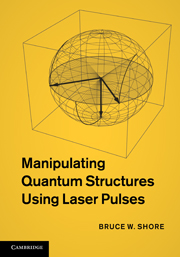Book contents
- Frontmatter
- Contents
- Preface
- Acknowledgments
- 1 Introduction
- 2 Atoms as structured particles
- 3 Radiation
- 4 The laser–atom interaction
- 5 Picturing quantum structure and changes
- 6 Incoherence: Rate equations
- 7 Coherence: The Schrödinger equation
- 8 Two-state coherent excitation
- 9 Weak pulse: Perturbation theory
- 10 The vector model
- 11 Sequential pulses
- 12 Degeneracy
- 13 Three states
- 14 Raman processes
- 15 Multilevel excitation
- 16 Averages and the statistical matrix (density matrix)
- 17 Systems with parts
- 18 Preparing superpositions
- 19 Measuring superpositions
- 20 Overall phase; interferometry and cyclic dynamics
- 21 Atoms affecting fields
- 22 Atoms in cavities
- 23 Control and optimization
- Appendix A Angular momentum
- Appendix B The multipole interaction
- Appendix C Classical radiation
- Appendix D Quantized radiation
- Appendix E Adiabatic states
- Appendix F Dark states; the Morris–Shore transformation
- Appendix G Near-periodic excitation; Floquet theory
- Appendix H Transitions; spectroscopic parameters
- References
- Index
- Frontmatter
- Contents
- Preface
- Acknowledgments
- 1 Introduction
- 2 Atoms as structured particles
- 3 Radiation
- 4 The laser–atom interaction
- 5 Picturing quantum structure and changes
- 6 Incoherence: Rate equations
- 7 Coherence: The Schrödinger equation
- 8 Two-state coherent excitation
- 9 Weak pulse: Perturbation theory
- 10 The vector model
- 11 Sequential pulses
- 12 Degeneracy
- 13 Three states
- 14 Raman processes
- 15 Multilevel excitation
- 16 Averages and the statistical matrix (density matrix)
- 17 Systems with parts
- 18 Preparing superpositions
- 19 Measuring superpositions
- 20 Overall phase; interferometry and cyclic dynamics
- 21 Atoms affecting fields
- 22 Atoms in cavities
- 23 Control and optimization
- Appendix A Angular momentum
- Appendix B The multipole interaction
- Appendix C Classical radiation
- Appendix D Quantized radiation
- Appendix E Adiabatic states
- Appendix F Dark states; the Morris–Shore transformation
- Appendix G Near-periodic excitation; Floquet theory
- Appendix H Transitions; spectroscopic parameters
- References
- Index
Summary
The traditional Raman process alluded to in Chap. 13 is a three-state sequence of transitions in which radiative excitation (induced by a pump field) is followed by spontaneous emission that produces a final state differing from the initial state [Her50b] [Sho90, § 17.5]. When the final state of the sequence is more energetic than the initial state the resulting emission line (to the red of the pump wavelength) is known as a Stokes spectral line. The difference between the pump frequency and the Stokes frequency, the Raman frequency, defines the excitation energy of the final state relative to the initial state. When, instead, the final state has lower energy than the initial state, as can occur when the initial quantum state is already excited, then the emission is an anti-Stokes line, at a bluer wavelength than the pump field. The overall Raman scattering is a two-photon process.
Typically Raman spectroscopy deals with molecules; the two-photon transitions are then between vibrational-rotational states, through electronically excited intermediate states, that are characterized in part by vibrational quantum number v and rotational angular momentum quantum numbers J, M. From any given excited electronic state there are many fluorescing transitions, corresponding to various vibrational and rotational quantum numbers of the final state. The wavelengths of the various Stokes and anti-Stokes lines (i.e. the Raman frequencies) characterize the particular molecular species, and so they have provided a valuable diagnostic tool for spectroscopists.
- Type
- Chapter
- Information
- Manipulating Quantum Structures Using Laser Pulses , pp. 222 - 252Publisher: Cambridge University PressPrint publication year: 2011

